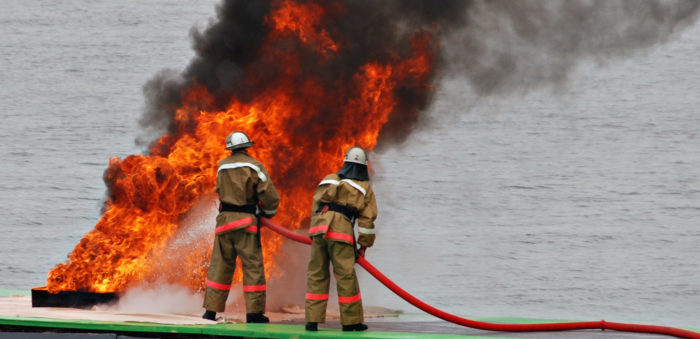The USCG issued a notice of proposed rulemaking to amend the rules for recreational vessels by moving fire extinguishing equipment standards for recreational vessels from the uninspected vessel subchapter, which includes requirements for both recreational and commercial vessels, to the subchapter applicable only to recreational vessels. This proposed move would relieve owners of recreational vessels from having to adhere to NFPA 10 fire extinguisher inspection, maintenance, and recordkeeping requirements intended to apply to commercial vessels only. This would not alter fire extinguishing equipment standards for commercial vessels, but would correct an incongruity in our regulations.
This proposed rule is discussed in the following three steps:
- Remove recreational vessel fire extinguishing equipment regulations from 46 CFR subpart 25.30 (Fire Extinguishing Equipment).
(a) Fire extinguishing equipment regulations in 46 CFR subpart 25.30 (Fire Extinguishing Equipment) currently apply to all motorboats and motor vessels (as defined by 46 CFR 24.10-1), both recreational and commercial. In order to make subpart 25.30 regulations apply to commercial vessels only, the Coast Guard proposes to revise the applicability section in 46 CFR 25.30-1 so that the fire extinguishing equipment regulations in subpart 25.30 would explicitly not apply to recreational vessels.
(b) The other requirements in part 25 (life preservers, navigation lights, ventilation, etc.) will not be changed or moved to Title 33 of the CFR because they either expressly exclude recreational vessels or already exist in the Title 33 provisions for recreational vessels.
- Move all of the fire extinguishing equipment regulations for recreational vessels from 46 CFR subpart 25.30 to 33 CFR part 175, subpart E, and revise the regulations to no longer require recreational vessel owners and operators to follow the monthly visual inspection, annual maintenance, and recordkeeping requirements of NFPA 10.
(a) The Coast Guard would create a new subpart E, Fire Protection Equipment, under part 175 (Equipment Requirements) in 33 CFR subchapter S (Boating Safety), and add the fire extinguishing equipment regulations from 46 CFR subpart 25.30 to that new subpart.
(b) The Coast Guard would limit the applicability of this new subpart to recreational vessels, as defined in 33 CFR 175.3, with propulsion machinery to clarify that the fire extinguishing equipment requirements would not apply to non-motorized sail boats, kayaks, canoes, and other human powered recreational vessels that do not require portable fire extinguishers. The fire extinguishing equipment requirements added to subpart E would be the same as in current 46 CFR subpart 25.30, but would be modified to clarify the regulatory language, update outdated information, and omit the requirement for recreational vessels to comply with NFPA 10.
- Update text in 33 CFR part 175, new subpart E—Fire Protection Equipment.
(a) The Coast Guard would make several small administrative changes to the text being moved from 46 CFR subpart 25.30 to new 33 CFR part 175 subpart E, to clarify the regulatory language and update outdated information.
(b) The Coast Guard would change the terms “motorboats” and “motor vessels,” as currently used in subpart 25.30, to more clear terms of “Recreational vessels 65 feet and less in length” and “Recreational vessels more than 65 feet in length” respectively.
This change would align the language used in new subpart E with the terminology already used in 33 CFR part 175, and reinforce the subpart’s intent to apply the requirements to recreational vessels, and not all motorboats and motor vessels. It would also make clearer the distinction between the two vessel size categories, allowing readers to easily find the fire extinguishing equipment requirements appropriate for a particular type of vessel.
(c) The Coast Guard would add new language to clarify acronyms, and update cross-references to 46 CFR subpart 25.30. For example, replacing the B.H.P. acronym with “brake horse power” and updating references to clearly point towards 46 CFR instead of chapter I.
(d) The Coast Guard would modify the language moved from 46 CFR subpart 25.30 to refer to recreational vessels by model years, as opposed to contracting or manufacturing dates. The latter are applicable to commercial vessels only. This change would allow the recreational boating community to more easily identify their vessel Start Printed Page 20830requirements, and it would align with industry and market naming practices.
(e) Because this rule is not intended to and would not change any exceptions that already apply to recreational vessels, the Coast Guard proposes to retain all the existing recreational fire extinguishing equipment exemptions, such as those for vessels manufactured before August 22, 2016, and the fire extinguishing equipment exemptions for vessels manufactured before November 19, 1952, as provided in 46 CFR 25.30-80 and 46 CFR 25.30-90.
In summary, the Coast Guard proposes separating recreational vessel fire extinguishing equipment rules from commercial vessel fire extinguishing equipment rules, and consolidating recreational vessel-specific requirements into one part, which would not contain NFPA 10 visual inspection, annual maintenance, and recordkeeping requirements for recreational vessels. This change would affect only recreational vessels with propulsion machinery, and would not affect commercial vessels.
For more information, click on the PDF herebelow































































